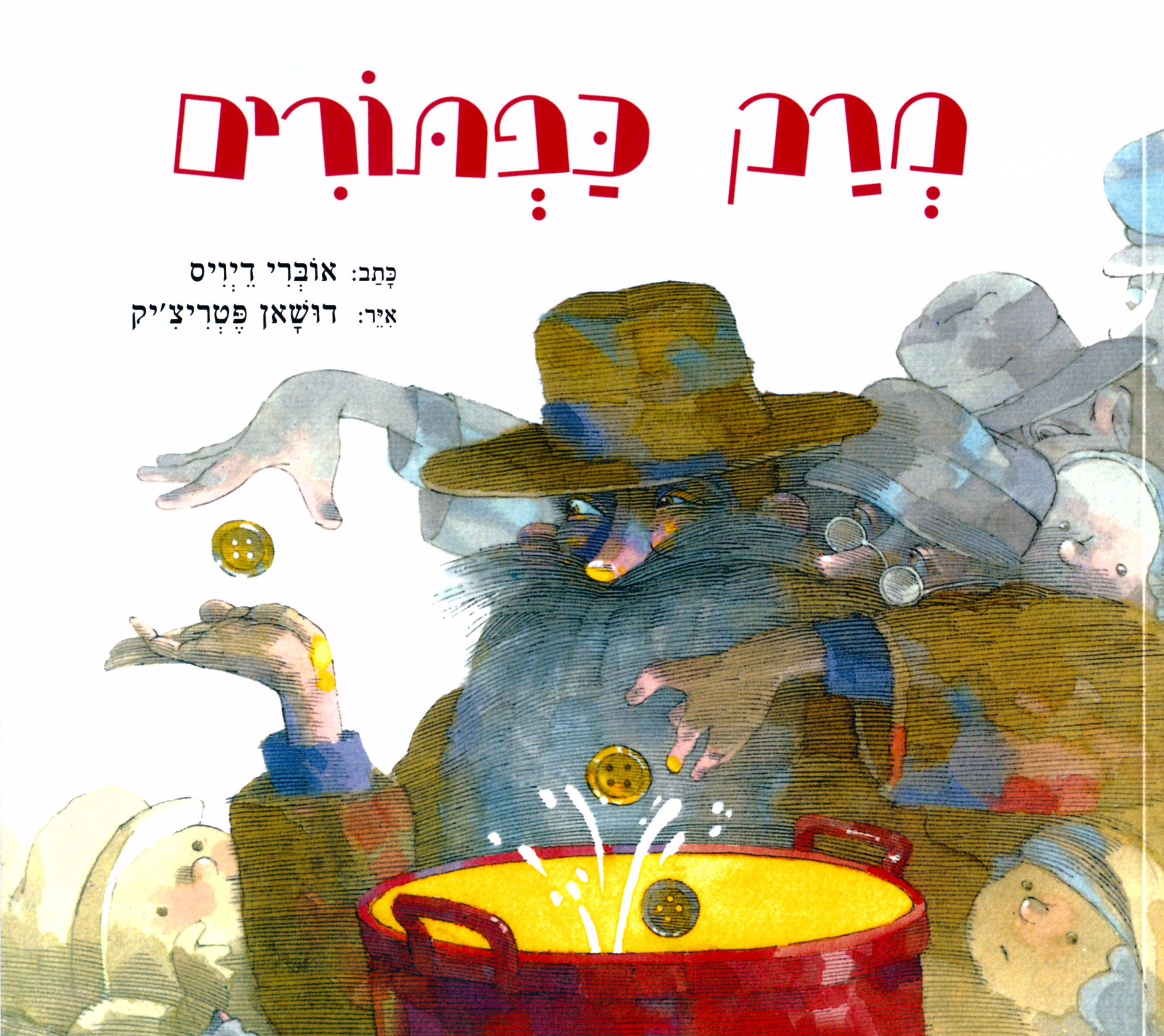מרק כפתורים/ אוברי דייויס
תרגום לרוסית של ההצעות להורים המודפסות בעמודים הראשונים של הספר.
Пуговичный суп Обри Дейвис
Дорогие родители!
Что делать голодному нищему страннику, который приходит в городок, где никто не открывает ему двери?
С помощью ума и предприимчивости ему удается не только раздобыть себе еду, но и улучшить отношение жителей городка к себе и друг к другу. Эта народная сказка существует в разных версиях у многих народов мира. В версии, которая перед вами, сказка разворачивается на фоне еврейского городка (штетла) давних лет. Можно по-разному прочитать и понять этот рассказ, и мы уверены, что вы найдете в нем новые грани при каждом прочтении. Мы предлагаем вам несколько мыслей и идей для беседы и занятий с детьми.
«И будет он жить с тобою»
Жители городка очень изменяются от начала рассказа и до его конца. В началe рассказа все двери городка закрыты перед стрвнником и никто из жителей не готов помочь ему. Поведение жителей городка противоречит одной из основных еврейских заповедей: помощи ближнему. Тора во многих местах призывает нас помогать тем, кто нуждается в помощи. Например, в книге «Ваикра» в главе «Беар» 25: 35-36 есть заповедь, которая говорит «И если обеднеет брат твой и придет в упадок у тебя, то поддержи его, пришелец ли он или поселенец, и будет он жить с тобою».
В течение многих лет мудрецы устанавливали разные законы, относящиеся к заповедям благотворительности. Рамбам писал, что даже бедняк, живущий на подаяния, обязан сам подавать милостыню. Значение его слов в том, что каждый может помочь ближнему хоть чем-нибудь.
Предложения для беседы и занятий:
____ «Странно, что здесь происходит?» - спрашивает нищий. Побеседуйте с детьми о том, что происходит в городке. Почему никто не приглашает странника в дом? Представьте, что вы и ваш ребенок стучите в двери жителей городка и спрашиваете: «Что с вами? Почему вы не открываете двери нищему страннику?» Какие ответы могли бы дать жители городка?
_____ Маленький ребенок не должен открывать двери нищим или другим незнакомым людям. В нашей действительности мы вынуждены предупреждать детей не открывать дверь незнакомым людям. Тогда какой же самый лучший способ помочь? Побеседуйте с детьми о том, как вы помогаете другим, даже если вы не приглашаете их к себе в дом. Подумайте вместе, как и кому могут помочь ваши дети. Подумайте, кому они смогут помочь и какую помощь смогут оказать.
____«Никто в этом городке не даст тебе пуговицу и даже пол-пуговицы… Все мы бедняки, господин странник, даже самим себе нам нечего дать» - говорит служка. Когда он добрался до городка, нищий стучал в дверь за дверью, но никто не пригласил его войти, никто не предложил еды. Каждый чувствовал, что у него ничего нет, так как же можно ожидать от него, чтобы он помог незнакомому нищему? Как же из «ничего» получился суп? Ситуация в городке полностью изменилась, несмотря на то, что все остались такими же бедными, какими были в начале рассказа. Что же случилось за это время?
____ После того, как суп съеден, жители городка поют, смеются и танцуют. Теперь они приглашают нищего к себе в гости. Прочитайте ребенку снова описание жителей городка. Что они «получили» от того, что «пожертвовали» для супа, что их так обрадовало и развеселило? Попробуйте вспомнить какое-либо событие, когда что-то хорошее и новое вышло из-за того, что каждый внес в него свой вклад.
___ Вспомните какой-нибудь случай, когда вы получили помощь, и поделитесь своими впечатлениями с ребенком (например, я была больна, и соседка помогла мне….). Спросите ребенка, может ли он вспомнить какой-нибудь случай, когда кто-то помог ему в садике, и как это случилось.
"Если не я для себя - то кто для меня? А если я только для себя - то кто я?» Человек и общество
В Мишне в «Поучениях отцов» (Глава 1, мишна 14) Гилель говорит: "Если не я для себя - то кто для меня? А если я только для себя - то кто я?»
Нищий странник в рассказе понимает, что если он сам себе не поможет, то ему не поможет никто. В этом значение слов «Если не я для себя - то кто для меня?». Взаимопомощь и забота о ближнем обогащают жизнь и расширяют ее смысл, и к этому относится вторая часть высказывания: «А если я только для себя - то кто я?».
Один из способов помочь себе и другим – организовать общину. В начале рассказа община в городке не действует: синагога пуста, все сидят по своим домам. С помощью нескольких пуговиц нищий превращает жителей городка из собрания одиночек в настоящую общину.
Община занимает центральное место в еврейской традиции, в любой точке земного шара, где жила группа евреев, создавались еврейские организации (синагоги, организации помощи ближнему и т.п.), которые гарантировали, что никто не останется один и без поддержки.
Из одной морковки можно приготовить только морковь, из одной луковицы только лук, а из кочана капусты? – Правильно, только капусту! Но когда мы кладем все овощи в кастрюлю и варим их вместе, получается что-то другое и большее, чем все составляющие. В этом прелесть общины: каждый вносит свой вклад и помогает создать нечто большее, имеющее добавочную ценность.
____ Прогуляйтесь со своими детьми по своему району и укажите им на общественные здания, организации и людей по дороге – например, библиотека, синагога, дом культуры, школа, сад, детская площадка. Есть ли среди этих организаций такие, в которых чувствуется дух общины? Существовали ли они также и в прошлом? Встречаем ли мы всегда одних и тех же людей в каждом из этих мест? Помогают ли люди друг другу в этих местах? Что из того, что делают люди вместе в этих местах, невозможно сделать одному?
____ Попытайтесь нарисовать на картоне общественный центр. После этого можно разрезать рисунок, сделать из него пазл и снова собрать. Обратите внимание ребенка на то, как каждая часть вносит свой вклад в создание целого.
____ Приготовьте свой собственный «пуговичный суп» ( конечно, без пуговиц!): пригласите домой друзей ребенка и попросите каждого принести что-нибудь для его приготовления. В то время, когда суп будет вариться, снова прочитайте детям этот рассказ.





